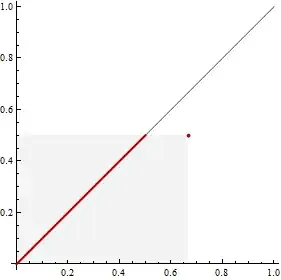Sometimes an easy way to show that a function of $n$ real variables is a copula is to exhibit it as the (cumulative) probability function of a particular random variable with uniform marginal distributions on the unit cube $[0,1]^n$. This thought leads immediately (and uniquely) to the following demonstration.
Let $(X,Y)$ be a bivariate random variable having a uniform distribution along the line segment $I$ from $(0,0)$ to $(1,1)$. By definition, this means that the probability that $(X,Y)$ is in some rectangle $B=[x_1,x_2]\times [y_1,y_2]$ is proportional to the length of $I$ lying inside $B$. It is geometrically obvious that
$$\Pr((X,Y)\in [0,x]\times [0,y]) = \min(x,y).$$

The dot shows a point $(x,y)$. The intersection of $I$ (shown as a gray diagonal line) with the rectangle $[0,x]\times [0,y]$ (shown as a shaded rectangle) is the thick red line. Its length is proportional to the smaller of $x$ and $y$; that is, to $\min(x,y)$.
The chance that $(X,Y)$ lies in an arbitrary rectangle $[x_1,x_2]\times [y_1,y_2] \subset [0,1]\times [0,1]$ is given by the inclusion-exclusion principle as
$$\eqalign{
\Pr((X,Y) \in [x_1,x_2]\times [y_1,y_2]) &=
\Pr((X,Y)\in [0,x_2]\times[0,y_2]) - \Pr((X,Y)\in [0,x_1]\times[0,y_2]) - \Pr((X,Y)\in [0,x_2]\times[0,y_1]) + \Pr((X,Y)\in [0,x_1]\times[0,y_1]) \\
&= \min(x_2,y_2) - \min(x_1,y_2) - \min(x_2, y_1) + \min(x_1,y_1).
}$$
The left hand side, because it is a probability, is non-negative, proving (3).
Incidentally, in addition to (2), you also have to show that $M(u,v) = 0$ whenever one of $u,v$ is $0$ (and all the others are in $[0,1]$)--but that's obvious. You do not have to demonstrate (1): it's a consequence of the other properties.
This demonstration extends without any essential modification to the $n$-dimensional copula $M(u_1,u_2,\ldots,u_n) = \min(u_i)$.
